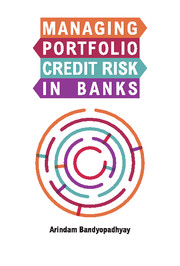Book contents
- Frontmatter
- Dedication
- Contents
- Tables, Figures, Charts
- Preface
- Acknowledgements
- Abbreviations
- 1 Introduction to Credit Risk
- 2 Credit Rating Models
- 3 Approaches for Measuring Probability of Default (PD)
- 4 Exposure at Default (EAD) and Loss Given Default (LGD)
- 5 Validation and Stress Testing of Credit Risk Models
- 6 Portfolio Assessment of Credit Risk: Default Correlation, Asset Correlation and Loss Estimation
- 7 Economic Capital and RAROC
- 8 Basel II IRB Approach of Measuring Credit Risk Regulatory Capital
- Index
3 - Approaches for Measuring Probability of Default (PD)
Published online by Cambridge University Press: 05 May 2016
- Frontmatter
- Dedication
- Contents
- Tables, Figures, Charts
- Preface
- Acknowledgements
- Abbreviations
- 1 Introduction to Credit Risk
- 2 Credit Rating Models
- 3 Approaches for Measuring Probability of Default (PD)
- 4 Exposure at Default (EAD) and Loss Given Default (LGD)
- 5 Validation and Stress Testing of Credit Risk Models
- 6 Portfolio Assessment of Credit Risk: Default Correlation, Asset Correlation and Loss Estimation
- 7 Economic Capital and RAROC
- 8 Basel II IRB Approach of Measuring Credit Risk Regulatory Capital
- Index
Summary
Probability of default (PD) quantifies the likelihood of a borrower that he will not be able to meet its contractual obligations and will default. Default does not necessarily lead to immediate losses, but may increase the likelihood of bankruptcy and, hence, subsequent losses. Default is uncertain. For the correct estimation of credit risk, banks first need to estimate the chance that the borrower will default over a certain time horizon. PD can be termed as the first dimension of measuring credit risk under the Basel II IRB approach. The internal ratings based (IRB) on the new Basel II accord allows banks to use their own internal credit ratings. Banks need to estimate rating-wise PD for the calculation of regulatory capital. The prime objective in modelling default risk is to measure credit risk in terms of default probabilities rather than ordinal rankings. By providing a PD for loan obligor, one is providing a forecast of the likelihood of default over the specified horizon (e.g. one year). This is true even if the historical default experience is used. PD can be estimated at an individual borrower level or at a portfolio level. The probability of default (PD) depends on borrower-specific factors such as the source of finance, financials, firm size, competitive factors, management factors as well as market-specific factors like business environment, unemployment rate, interest rate movements, etc. When credit quality of a borrower worsens, the probability of future default also increases.
The incident of default can be defined in several ways: missing a payment obligation, filing bankruptcy procedure, distressed exchange, breaking a covenant, etc. The definition of default employed in Basel II is based on two sets of conditions (at least one of the conditions must be met): first that “the bank considers that the obligor is unlikely to pay [in full]”, and second, that “the obligor's past due is more than 90 days on any material credit obligation”. The first is a subjective condition. The second is an objective condition, where the minimum number of days past due date that triggers default is 90 days, and the minimum past due threshold amount is the level of materiality fixed by the bank.
- Type
- Chapter
- Information
- Managing Portfolio Credit Risk in Banks , pp. 111 - 136Publisher: Cambridge University PressPrint publication year: 2016



